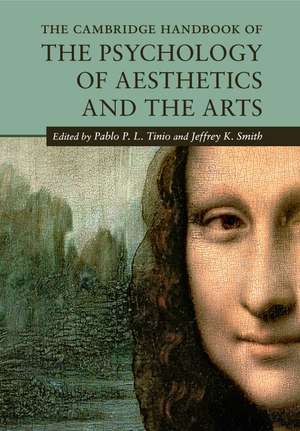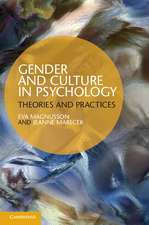The Cambridge Handbook of the Psychology of Aesthetics and the Arts: Cambridge Handbooks in Psychology
Editat de Pablo P. L. Tinio, Jeffrey K. Smithen Limba Engleză Paperback – 5 apr 2017
Din seria Cambridge Handbooks in Psychology
- 23%
 Preț: 1254.71 lei
Preț: 1254.71 lei - 11%
 Preț: 449.49 lei
Preț: 449.49 lei -
 Preț: 502.52 lei
Preț: 502.52 lei - 23%
 Preț: 1248.79 lei
Preț: 1248.79 lei - 8%
 Preț: 426.60 lei
Preț: 426.60 lei -
 Preț: 486.56 lei
Preț: 486.56 lei - 5%
 Preț: 441.42 lei
Preț: 441.42 lei - 9%
 Preț: 1282.44 lei
Preț: 1282.44 lei -
 Preț: 494.25 lei
Preț: 494.25 lei - 8%
 Preț: 429.69 lei
Preț: 429.69 lei - 9%
 Preț: 594.29 lei
Preț: 594.29 lei - 23%
 Preț: 1246.12 lei
Preț: 1246.12 lei - 5%
 Preț: 397.85 lei
Preț: 397.85 lei - 8%
 Preț: 424.41 lei
Preț: 424.41 lei -
 Preț: 501.96 lei
Preț: 501.96 lei - 19%
 Preț: 494.19 lei
Preț: 494.19 lei - 5%
 Preț: 718.49 lei
Preț: 718.49 lei -
 Preț: 511.59 lei
Preț: 511.59 lei - 8%
 Preț: 426.60 lei
Preț: 426.60 lei - 8%
 Preț: 427.05 lei
Preț: 427.05 lei - 8%
 Preț: 425.42 lei
Preț: 425.42 lei -
 Preț: 411.92 lei
Preț: 411.92 lei -
 Preț: 272.35 lei
Preț: 272.35 lei - 8%
 Preț: 425.42 lei
Preț: 425.42 lei -
 Preț: 511.21 lei
Preț: 511.21 lei -
 Preț: 370.88 lei
Preț: 370.88 lei -
 Preț: 374.90 lei
Preț: 374.90 lei - 8%
 Preț: 489.89 lei
Preț: 489.89 lei - 8%
 Preț: 427.49 lei
Preț: 427.49 lei -
 Preț: 511.59 lei
Preț: 511.59 lei - 5%
 Preț: 1538.86 lei
Preț: 1538.86 lei - 23%
 Preț: 2195.06 lei
Preț: 2195.06 lei - 8%
 Preț: 428.36 lei
Preț: 428.36 lei -
 Preț: 488.47 lei
Preț: 488.47 lei - 8%
 Preț: 420.13 lei
Preț: 420.13 lei - 9%
 Preț: 850.12 lei
Preț: 850.12 lei - 8%
 Preț: 430.05 lei
Preț: 430.05 lei -
 Preț: 497.35 lei
Preț: 497.35 lei -
 Preț: 283.03 lei
Preț: 283.03 lei
Preț: 487.33 lei
Nou
Puncte Express: 731
Preț estimativ în valută:
93.28€ • 101.36$ • 78.41£
93.28€ • 101.36$ • 78.41£
Carte tipărită la comandă
Livrare economică 22 aprilie-06 mai
Preluare comenzi: 021 569.72.76
Specificații
ISBN-13: 9781108402675
ISBN-10: 1108402674
Pagini: 646
Ilustrații: 41 b/w illus. 6 tables
Dimensiuni: 170 x 245 x 34 mm
Greutate: 1.02 kg
Editura: Cambridge University Press
Colecția Cambridge University Press
Seria Cambridge Handbooks in Psychology
Locul publicării:Cambridge, United Kingdom
ISBN-10: 1108402674
Pagini: 646
Ilustrații: 41 b/w illus. 6 tables
Dimensiuni: 170 x 245 x 34 mm
Greutate: 1.02 kg
Editura: Cambridge University Press
Colecția Cambridge University Press
Seria Cambridge Handbooks in Psychology
Locul publicării:Cambridge, United Kingdom
Cuprins
Part I. Concepts, Theories and Methods: 1. Introduction by the editors Jeffrey K. Smith and Pablo P. L. Tinio; 2. Empirical aesthetics: hindsight and foresight Oshin Vartanian; 3. Philosophy of art and empirical aesthetics: resistance and rapprochement William P. Seeley; 4. Theoretical foundations for an empirical aesthetics Gerald C. Cupchik; 5. Aesthetics assessment Aaron Kozbelt and James C. Kaufman; Part II. Perspectives and Approaches to Art and Aesthetics: 6. Beyond perception: information processing approaches to art appreciation Helmut Leder; 7. Psychodynamics and the arts Pavel Machotka; 8. Evolutionary approaches to art and aesthetics Marcos Nadal and Gerardo Gómez-Puerto; 9. The walls do speak: psychological aesthetics and the museum experience Pablo P. L. Tinio, Jeffrey K. Smith and Lisa F. Smith; Part III. Objects and Media: 10. Empirical investigation of the elements of composition in paintings: a painting as stimulus Paul J. Locher; 11. 'Mute, motionless, variegated rectangles': aesthetics and photography I. C. McManus and Katharina Stöver; 12. Aesthetic responses to design: a battle of impulses Paul Hekkert; 13. From music perception to an integrative framework for the psychology of aesthetics Stefan Koelsch; 14. Theater and dance: another pathway to understanding human nature Thalia R. Goldstein and Rebecca Yasskin; 15. Arts education, academic achievement and cognitive ability Swathi Swaminathan and E. Glenn Schellenberg; 16. Aesthetics and the built environment: no painting or musical piece can compare Andréa Livi Smith; 17. Mirror, mirror on the wall, who's the fairest one of all? Influencing factors and effects of facial attractiveness Gernot Gerger and Helmut Leder; 18. An aesthetics of literary fiction David Carr; Part IV. Contemporary Issues and Debates: 19. Neuroaesthetics: descriptive and experimental approaches Anjan Chatterjee; 20. How emotions shape aesthetic experiences Stefano Mastandrea; 21. Unusual aesthetic states Emily C. Nusbaum and Paul J. Silvia; 22. Personality and aesthetic experiences Viren Swami and Adrian Furnham; 23. Hokusai and Fuji: cognition, convention and pictorial invention in Japanese pictorial arts David Bell; Part V. Pulling it All Together: 24. And all that jazz: rigour and relevance in the psychology of aesthetics and the arts Pablo P. L. Tinio and Jeffrey K. Smith.
Recenzii
'This book is a significant contribution to furthering our understanding about the importance and value of aesthetics within different art forms and contexts. It has cross-disciplinary appeal and helps to promote both theoretical development and applied research, while opening the study of aesthetics to a broader audience.' Paul M. Camic, Salomons Centre for Applied Psychology, Canterbury Christ Church University, Kent
'This volume is impressive in both its breadth and depth. I work in this area, yet I learned something from each and every chapter about the psychology of aesthetics and art, and - perhaps more importantly - how aesthetics and art contribute to the human condition. This book will be kept on my desk so I can have easy access to it!' Jonathan Plucker, Raymond Neag Professor of Education, University of Connecticut
'This volume brings together important scholarship and groundbreaking methodological approaches for understanding the fundamental question of how and why art moves us. Although an individual's experience of art is inherently subjective, these collected essays draw on research in psychology and aesthetics to bring new insights to a topic that historically many scholars in the field had considered too indefinable to analyze or quantify.' Kathryn Potts, Helena Rubinstein Chair of Education, Whitney Museum of American Art
'This volume is impressive in both its breadth and depth. I work in this area, yet I learned something from each and every chapter about the psychology of aesthetics and art, and - perhaps more importantly - how aesthetics and art contribute to the human condition. This book will be kept on my desk so I can have easy access to it!' Jonathan Plucker, Raymond Neag Professor of Education, University of Connecticut
'This volume brings together important scholarship and groundbreaking methodological approaches for understanding the fundamental question of how and why art moves us. Although an individual's experience of art is inherently subjective, these collected essays draw on research in psychology and aesthetics to bring new insights to a topic that historically many scholars in the field had considered too indefinable to analyze or quantify.' Kathryn Potts, Helena Rubinstein Chair of Education, Whitney Museum of American Art
Descriere
This book presents groundbreaking research and thinking on our interactions with artworks, literature, poetry, music, movies, performances, architecture and design.









